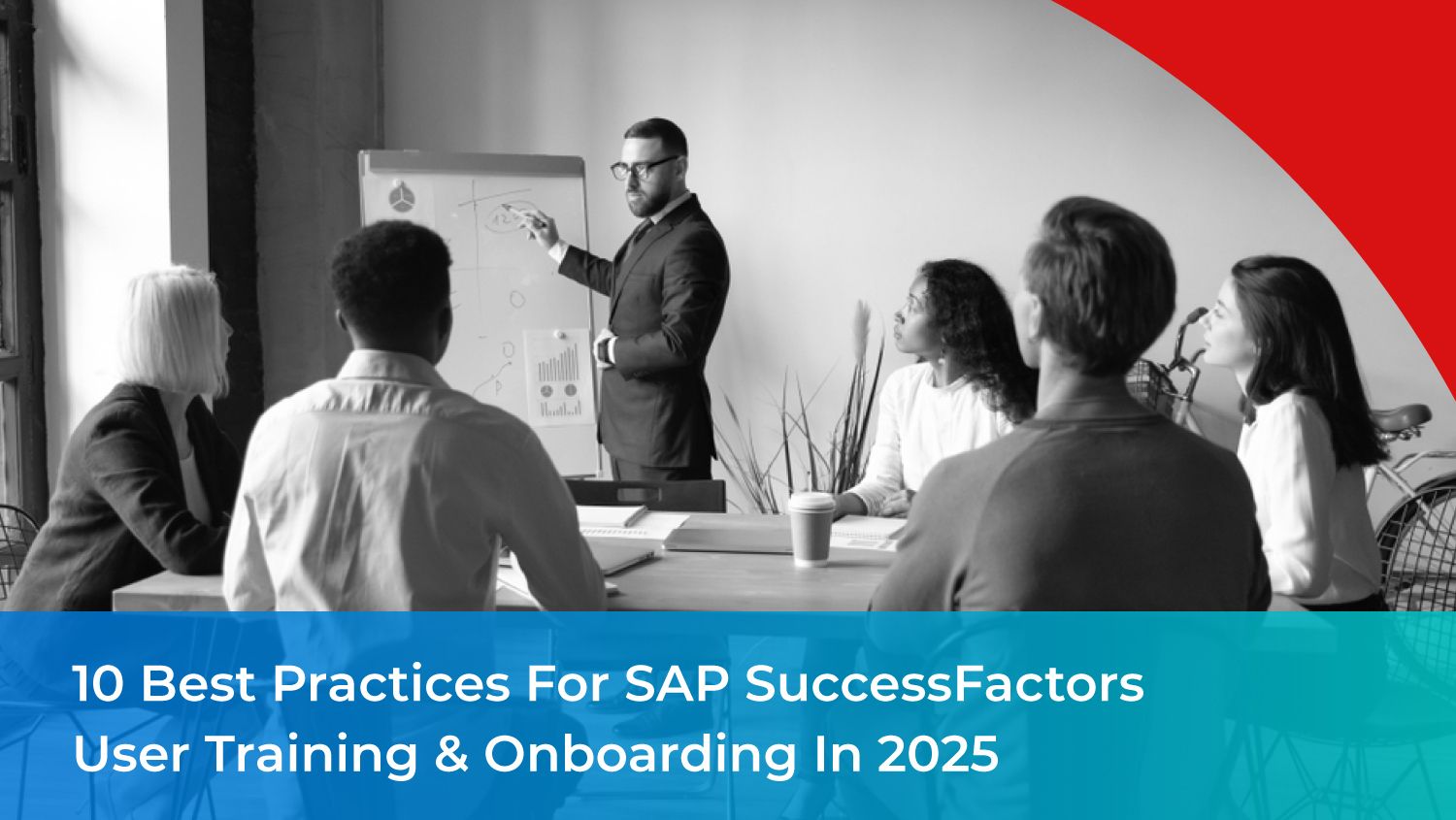Struggling to keep your talent pipeline flowing and high performers engaged?
In today's competitive business landscape, HR leaders need a powerful solution that goes beyond basic data storage. That's where SAP SuccessFactors come in.
It's a comprehensive Human Capital Management (HCM) platform designed to transform your talent management from reactive to proactive.
With around 1000+ processes, it’s a well-rounded solution for employees, managers, HR administrators, and higher authorities(CHROs) to increase collaboration across the organization.
SAP SuccessFactors is a system that connects data, decisions, and people – all accessible at the right time. Due to its use, your organization can streamline communication flows and allow thriving collaboration within teams.
But implementing a new system isn't always smooth sailing. New user adoption and maximizing the platform's potential can be hurdles.
Thus, in this blog, we'll explore best practices for transforming your organization's SAP SuccessFactors user training and onboarding into a game-changing experience after implementation.
10 Best Practices for User Training and Onboarding for SAP SuccessFactors
1. Start with the Online Learning Approach
75% of employers already use online training and courses for training purposes. And SAP SuccessFactors is no exception!
SAP SuccessFactors training is offered online and is available on their official website. In addition, they have SAP SuccessFactors Learning Hub, SuccessFactors Administrator Learning Center, and SAP SuccessFactors Community for customers and partners.
But don’t you think a hybrid workforce needs a little bit more than that?
SAP SuccessFactors is highly customizable, from the UI design to content in the main quick Tiles. And the help section has video tutorials and PDFs for user learning and doubts. But then the experience is not really what we call ‘user-friendly’.
Thus, you may start with the learning modules SAP SuccessFactors provides, but eventually, you will need to consider other training approaches.
2. Document the process
Lack of documentation eventually becomes a problem for acceptance. So, why not consider penning down the SuccessFactors training and onboarding process?
New joiners can glance through these simple notes and get acquainted with HCM software. In addition, it will take some burden off recruiters to give a rundown every time someone new is in the picture.
A trial and error method is initially necessary to plan a long-term usage strategy. And by documenting these procedures, you will have a pre-planned approach to new changes.
3. Take help from a “Certified Application Consultant”
SAP SuccessFactors is a substantial buy. Having an application consultant isn't good enough; you need a certified one as some can be a hoax. It's optional practice to follow but if you have yet to consult with a certified professional, now is the time to search for one.
A consultant can assist in every phase of a cloud implementation, including offer, realization, verification, training, and transition. Additionally, they actively coordinate software rollouts.
A handful of Linkedin groups provide live interactive training by certified industry expert trainers and give on-demand dedicated cloud lab access.
4. Gamifying the onboarding process
Within SAP SuccessFactors' Learning Modules, Scenarios, and Exercises components, gamification opportunities abound. But wait, what is Gamification and should you consider it?
Gamification involves incorporating game-like dynamics into your content, site, and campaign. For example, if you want to create an AHA moment for onboarding, what could be a better way than making learning fun? Gamifying their onboarding experience increases engagement and participation in a fast and fun way.
The 'Achievements' section of SAP SuccessFactors houses all the gamification. You will see the earned points, current status, and progress bar just like you have when in a game. Companies must set up game servers before they can administer game settings in SAP SuccessFactors Learning. There are available partners that can do that for you!
Authorities can plan their gamification efforts according to the long-term vision, ensuring the completion of more significant milestones, using real-time simulations, evaluating learners' performance monthly, and more.
5. Make it Interactive with walkthroughs
Human assistance is always the best way to solve a fellow query. But is that possible every time someone has the tiniest doubt?
Interactive Walkthroughs can ease the whole process and help users navigate the SuccessFactors features smoothly. Embedding these guided tours gives a real-time experience on the same screen and acts like an anchor for the user. It pops up in a proactive way keeping user-centricity at the core.
That's not surprising as Building Staff Engagement Report found that walkthroughs result in a 23% quicker rollout and a 12% shorter time to competency. And what's better than learning while at work?
You will be amazed at how Gyde's walkthrough for SuccessFactors shows up exactly when you need it.
6. Tailored Training Programs and RBP
When you turn to a digital adoption platform, they usually have a database of all possible processes. Therefore, you can pick and choose the processes that are suitable to your organization's needs.
An organization must train its employees in RBP (Role-based permissions). It should involve employees providing feedback and managers taking care of performance management. And that is possible by granting RBPs to the right people. For example, each user group assigns individual roles and then gives permissions. It is what we call personalized and contextual RBP.
While devising an employee training plan for 2025, it's essential that you have aligned the entire organization and understood the company's approach.
7. Use Analytics to your advantage
User analytics present in digital adoption platforms are an excellent way to track usage, trends, and performance. Identifying the pain points, especially for remote users, can help team managers learn about non-accessible features.
Digital adoption platforms can then help bring these non-accessible features to the user's attention.
You can decide the frequency you will be checking and running these reports. Interestingly, analytics help you track down user behavior and find out the relevant KPIs(key performance indicators).
When discussing best practices, collecting data and evidence at the beginning of any engagement is advised. This data is your KPI. The data will have daily/monthly active users, adoption rate, average time spent using a product, and retention.
Based on these indicators, you can understand how well your users adapt to SAP SuccessFactors. If they are not resonating with the provided helpful resources, it might be an indication to make a change in them.
8. Guide them in their own language
If you train your employees in their native language, SAP SuccessFactors training can be as easy as ABC. Investing in a platform that can do that for you is a golden opportunity to expand your market opportunities.
In recent years, companies have faced an increasingly complex challenge of balancing the tension between multiple forces (geography, product, market, and technology) across distant locations. It will thus result in a positive user experience if training and onboarding are provided with multilingual help.
When the user searches with desired keywords, you can have guides/walkthroughs/help articles in any language the user chooses. After all, language is a facilitator and not a roadblock to learning!
9. Consider Modular Approach for Training End Users
For SuccessFactors training end users, it's essential to consider the modular approach. Modular means you break up your training into smaller pieces so the user can get through them more quickly and efficiently. This can be done by breaking up your content into modules with related concepts or themes that build on each other as they progress through the course.
For example, if you teach a user about Employee Profile in SAP SuccessFactors, you might have several steps associated with this process (such as creating an account). You could break this process into modules such as "How To view your Employee Profile", "How to edit /add personal details?" and more.
You can get a digital adoption platform to break down these processes into guiding walkthroughs. Then, with help articles and walkthroughs, the modular approach becomes easier to apply.
10. Build Feedback cycles
It should be a preliminary practice to listen to your employees' suggestions right after the implementation is done. They will lend a perspective from a practical standpoint.
Leadership can address their concerns & doubts and take measures to improve execution. You are a good leader when you include your employees in decision-making.
When you are using a DAP, they are likely to provide you with seamless feedback on walkthroughs and help article content. You can further use it to tweak or add content and build an engaging in-app experience. They also offer contextual help on any desired feature used in SAP SuccessFactors(Any Quick Tiles like My Profile, Org Chart, or My Team).
"Feedback cycles" mean creating continuity in the organization's feedback process. SAP SuccessFactors should be mapped out for employees and revisited monthly to ensure transparency.
Ending Notes
Finally, by implementing these best practices and leveraging Digital Adoption Platforms (DAPs), you can create a more streamlined and engaging onboarding and training experience for your employees in SAP SuccessFactors.
Think of it this way:
Traditional training methods are like a static paper map. They require effort to navigate and can quickly become outdated.
DAPs, on the other hand, are like a dynamic GPS system. They provide real-time guidance, personalized to the specific task at hand, ensuring your employees are always on the right track.
Investing in a platform such as Gyde DAP supports continuous software learning for your employees. Some of its benefits will be faster onboarding, improved software adoption, swift application ROI and a more productive workforce.
Get in touch with their top digital adoption experts and take a free demo on how we can make your employees' SAP SuccessFactors experience more efficient and more engaging!
FAQs
- What are SAP best practices for SAP SuccessFactors performance & goals?
SAP Best Practices for SAP SuccessFactors Performance & Goals solution improves the quality and speed of goal & performance management processes – and helps make an impact on scalable business results.
- Do I need a consultant to upgrade SAP SuccessFactors?
To perform activities, we recommend that an SAP SuccessFactors certified consultant performs the SAP Best Practices for SAP SuccessFactors upgrades.
- How long does it take to learn SuccessFactors?
A self-paced course, where all training happens through recorded presentations, demonstrations, and optional check-ins with an instructor every day, is expected to take around 20 hours to complete.
- How to integrate SAP SuccessFactors with SAP HCM?
Follow these steps to integrate SAP SuccessFactors with SAP HCM-
- Log in to SuccessFactors System
- Go to Admin Center
- Click on Set User Permission -> Manage Permission Roles
- Select the role of the user to whom the Integration Center access should be granted:
- Click on Permissions
- Search for manage integration tools and then check the option Access to integration center also check the options related to OData API
- Click on Done, and Click on Save Changes
- Now log out of the instance and once again log in back using the user for which the permission was granted.
- Go to Admin Center, in the tool search type “Integration Center”, and you will be able to access the same
- What content can be integrated with SuccessFactors?
From external application tracking systems to Microsoft Teams, SuccessFactors can be integrated with pretty much anything.

